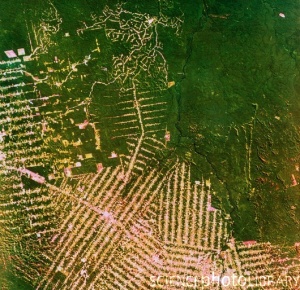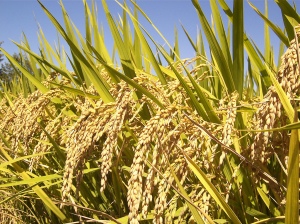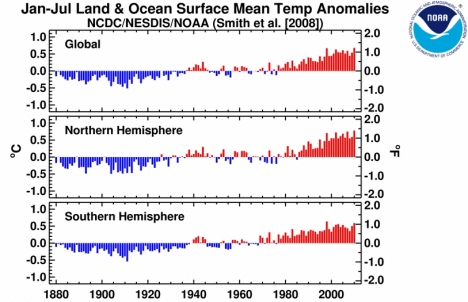
False-colour satellite image of humans moving into rainforest space in Brazil. The colours have been chosen to highlight the destruction of the rain forest: the dark green of the natural forest contrasts the pale green and pinks of levelled forest. Credit: NRSC Ltd / Science Photo Library
The natural world is under threat from a human pincer movement, Conservation International scientist Will Turner pointed out last week. As well as being impacted by human-caused climate change, natural systems are threatened by how people respond to that change, he emphasises. “Very little time has been taken to consider what our responses to climate change might do to the planet,” Turner said. Consequently, Turner teamed up with researchers at Princeton University and the University of Massachussetts to highlight what has happened already, and what may happen in the future.
“Renewable energy, for example, is integral to virtually every national or international strategy for curbing emissions, including plans to promote biofuels,” the team wrote in a Conservation Letters paper published online ahead of print. “However, rising U.S. ethanol production has been linked to losses of grassland habitats in the Conservation Reserve Program, while booming demand for palm oil, including for use as a biofuel, spurred the clearing of more than 28,000 km2 of Malaysia and Indonesia’s megadiverse forests from 1990 to 2005.”
The researchers also point out that biodiversity may suffer if climate change reduces how successfully food is produced, as humans use more land and water. “If overall yield is reduced or curtailed due to climate change, priority areas for biodiversity conservation in and near agricultural landscapes may face increased risk of conversion to crops,” they write.
“Climate change mitigation and adaptation are essential,” Turner said. “We have to ensure that these responses do not compromise the biodiversity and ecosystem services upon which societies ultimately depend. We have to reduce emissions, we have to ensure the stability of food supplies jeopardized by climate change, we have to help people survive severe weather events – but we must plan these things so that we don’t destroy life-sustaining forests, wetlands, and oceans in the process.”

Around three billion people eat rice every day, and the more than 60 percent of the world’s one billion poorest and undernourished people who live in Asia depend on rice as their staple food. Credit: IRRI
Turner’s team’s point about space needed for food was forced home this week by another group including UN Food and Agriculture Organization, Philippines and US government affiliated scientists underlining that higher temperatures will slow the growth of rice harvests. “As the daily minimum temperature increases, or as nights get hotter, rice yields drop,” said University of California, San Diego’s Jarrod Welch. Yield growth rates have fallen by 10-20 percent in several locations over the past 25 years, Welch and his colleagues say.
Welch and his co-workers studied rice growth data from 227 farms in six countries, in another advance online paper, this time in Proceedings of the National Academy of Sciences. “Our study is unique because it uses data collected in farmers’ fields, under real-world conditions,” said Welch. “This is an important addition to what we already know from controlled experiments.”
On that basis, rice harvests will certainly increase yet more slowly, and may even begin to shrink, given that US National Climate Data Centre’s measurements published this week show that the world officially sweltered again in July. The global combined average land and ocean surface temperature for July was 16.5°C, the second warmest on record and 0.66°C above the 20th century average of 15.8°C. At 14.5°C, the same measure taken over the January-July period was the warmest on record, 0.68°C above the 20th century average. July was the hottest ever in the Northern Hemisphere, with the heatwave in Russia being perhaps the most extreme example.



August 15, 2010 at 11:18 am
What a very interesting article ! I like it …I can relate myself to this in food for thought !
December 22, 2010 at 11:35 am
[…] temperature trends, trends in record temperatures in the US, average global annual temperatures for January-July, April, March, 2010 and 2009 overall. Plus I used the infamous “hockey-stick” graph […]